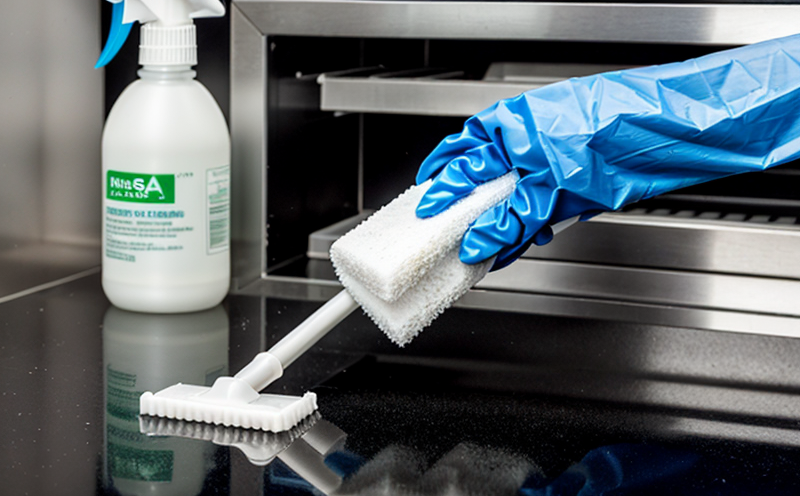DIN 58951 Sterilization Process Testing of Plastic Hygiene Containers
The DIN 58951 standard is a comprehensive guideline that ensures the proper sterilization process for plastic hygiene containers, such as those used in medical and personal care products. This service focuses on validating the effectiveness of sterilization processes to meet stringent hygiene and safety requirements.
Our laboratory employs state-of-the-art equipment and methodologies to simulate real-world conditions under which these containers are expected to function safely and effectively. This includes testing for residual microbial contamination, ensuring biocompatibility, and verifying that the materials do not degrade or release harmful substances during sterilization.
The DIN 58951 standard mandates specific parameters to be met during the sterilization process, including temperature, time, and method of sterilization (e.g., autoclaving, ethylene oxide gas). These parameters are critical for ensuring that plastic containers maintain their structural integrity, chemical stability, and hygienic quality after processing.
Our testing protocol begins with thorough preparation of the specimens. This involves cleaning the containers according to industry best practices, which may include washing with mild detergents or specialized cleaning agents designed to remove organic matter without compromising the material’s properties.
The sterilization process itself is meticulously monitored and recorded. We use high-temperature autoclaves capable of simulating the most challenging conditions encountered in industrial settings. Following sterilization, we conduct a series of tests to assess the performance of the containers:
- Bacterial Reduction Testing: This involves inoculating the cleaned container with a known bacterial culture and then subjecting it to the specified sterilization process. Afterward, the remaining bacteria are counted using microbiological techniques.
- Residual Sterilant Residue Analysis: Any residual sterilants must be removed from the containers post-sterilization to prevent potential harm to users. We analyze these residues using chromatographic methods and other analytical techniques to ensure compliance with regulatory limits.
- Material Integrity Assessment: The physical properties of the plastic, such as tensile strength and flexibility, are evaluated before and after sterilization to determine if any changes have occurred that could affect usability or safety.
- Biocompatibility Evaluation: This involves assessing whether the materials used in the containers can interact safely with human tissues. We follow ISO 10993 guidelines for biocompatibility testing, which includes cytotoxicity and inflammatory responses tests.
Our laboratory ensures that all results are documented meticulously and presented in a clear, concise manner. Detailed reports include comprehensive data on the sterilization process, test methods, and outcome analyses. Compliance with DIN 58951 is crucial for manufacturers to ensure their products meet regulatory requirements and consumer expectations.
The significance of this service extends beyond mere compliance; it plays a vital role in protecting public health by ensuring that hygiene containers are safe for use. By adhering strictly to the standards outlined in DIN 58951, we help our clients maintain a competitive edge in the market while upholding the highest standards of quality and safety.
Applied Standards
The DIN 58951 standard is part of a broader set of international guidelines that address the sterilization of medical devices and hygiene products. It specifically focuses on ensuring that plastic containers used in these applications undergo thorough testing to ensure they remain sterile post-sterilization.
For plastics, ISO 10993 provides additional guidance on biocompatibility, which is a critical factor when dealing with materials intended for contact with human tissues. ASTM E2842 and EN ISO 17665 are also relevant standards that provide supplementary information on the mechanical properties of polymeric materials under various stress conditions.
Our laboratory stays abreast of all these standards to ensure our testing methods remain current and effective. By adhering strictly to these guidelines, we can offer reliable data that supports regulatory compliance and product safety.
Benefits
- Enhanced Product Safety: By adhering to DIN 58951, we ensure that plastic hygiene containers are free from microbial contamination and remain safe for use.
- Regulatory Compliance: This service helps manufacturers meet stringent regulatory requirements, ensuring their products can be sold in various markets worldwide.
- Improved Brand Reputation: Demonstrating adherence to high standards of quality and safety enhances customer trust and loyalty.
- Competitive Advantage: Ensuring product safety and efficacy provides a competitive edge in the market, differentiating products from those that do not meet these rigorous standards.
The benefits extend beyond compliance; they contribute to the overall quality and reliability of plastic hygiene containers, ultimately improving public health and satisfaction. Our laboratory’s commitment to DIN 58951 reflects our dedication to excellence in every aspect of product testing.
Competitive Advantage and Market Impact
The implementation of DIN 58951 sterilization process testing offers several competitive advantages. Firstly, it ensures that products meet the highest standards of safety and efficacy, which is critical in an industry where consumer trust is paramount.
Secondly, compliance with this standard can open doors to new markets by meeting regulatory requirements in different regions. This broadens market reach and increases potential sales.
Thirdly, the rigorous testing process enhances brand reputation. Consumers are increasingly aware of the importance of product safety and hygiene. Demonstrating adherence to such a stringent standard can significantly boost customer confidence and loyalty.
In terms of innovation, adhering to DIN 58951 encourages manufacturers to explore new materials and processes that meet these high standards. This not only drives technological advancement but also sets the stage for future market leadership.
The impact on the market is profound as it fosters a culture of excellence in product development. By setting benchmarks for quality, DIN 58951 testing ensures that products are consistently reliable and safe, which is essential for long-term success in the hygiene and medical industries.





